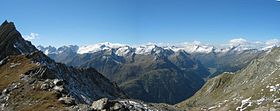Hohe Tauern National Park
| High Tauern | |
|---|---|

Panorama of the Venediger Group
|
|
| Highest point | |
| Peak | Grossglockner |
| Elevation | 3,798 m (12,461 ft) |
| Coordinates | 47°04′30″N 12°41′40″E / 47.07500°N 12.69444°E |
| Dimensions | |
| Length | 130 km (81 mi) |
| Width | 50 km (31 mi) |
| Geography | |
| Countries | Austria and Italy |
| States | Salzburg, Carinthia, Tyrol and South Tyrol |
| Range coordinates | 47°10′N 12°30′E / 47.167°N 12.500°ECoordinates: 47°10′N 12°30′E / 47.167°N 12.500°E |
| Parent range | Central Eastern Alps |
| Geology | |
| Orogeny | Alpine |
| Age of rock | Paleozoic |
| Type of rock | Gneiss, Schist |
The High Tauern (pl.; German: Hohe Tauern, Italian: Alti Tauri) are a mountain range on the main chain of the Central Eastern Alps, comprising the highest peaks east of the Brenner Pass. The crest forms the southern border of the Austrian state of Salzburg with Carinthia and East Tyrol, while a small part in the southwest belongs to the Italian province of South Tyrol. The range includes Austria's highest mountain, the Grossglockner at 3,798 metres (12,461 ft) above the Adriatic.
In the east, the range is adjoined by the Lower Tauern. For the etymology of the name, see Tauern.
According to the Alpine Club classification of the Eastern Alps, the range is bounded by the Salzach valley to the north (separating it from the Kitzbühel Alps), the Mur valley and the Murtörl Pass to the east (separating it from the Lower Tauern), the Drava valley to the south (separating it from the Southern Limestone Alps), and the Birnlücke Pass to the west (separating it from the Zillertal Alps).
...
Wikipedia

